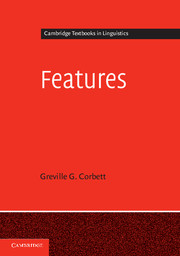Book contents
- Frontmatter
- Contents
- Figures
- Tables
- Preface
- Abbreviations
- 1 Why features?
- 2 Formal perspectives
- 3 Features for different components
- 4 Justifying particular features and their values
- 5 Typology
- 6 Canonical Typology and features
- 7 Determining feature values
- 8 Feature-value mismatches
- 9 Conclusions
- Appendix Standards and implementations
- References
- Author index
- Language index
- Subject index
- References
3 - Features for different components
Published online by Cambridge University Press: 05 November 2012
- Frontmatter
- Contents
- Figures
- Tables
- Preface
- Abbreviations
- 1 Why features?
- 2 Formal perspectives
- 3 Features for different components
- 4 Justifying particular features and their values
- 5 Typology
- 6 Canonical Typology and features
- 7 Determining feature values
- 8 Feature-value mismatches
- 9 Conclusions
- Appendix Standards and implementations
- References
- Author index
- Language index
- Subject index
- References
Summary
Features allow us to capture regularities in different components of the grammar. Some features operate just within a single component. For example, phonological features are solely a part of phonology: only rules of phonology may refer to them. But there are also features which apply across component boundaries, such as the well-known instance of morphosyntactic features (Matthews 1972: 162). The distinction has been around for many years, but Svenonius (2003: 376) suggests helpful terms: features available within a single component are ‘internal’ features, while those which apply across components are ‘interface’ features.
Provided we can define and distinguish the feature types clearly, we can maintain some interesting claims. First, syntax is phonology-free (Zwicky & Pullum 1983, Pullum & Zwicky 1988); that is, syntactic rules cannot refer to phonological features. A rule of the type ‘vowel-initial verbs take clause-final position’ is excluded. And second, syntax is also morphology-free (Zwicky 1992a: 354–56, Corbett & Baerman 2006; see §3.4.8 below); that is, syntactic rules cannot refer to morphological features. This principle excludes rules of the type ‘verbs of inflectional class ii take clause-final position’.
- Type
- Chapter
- Information
- Features , pp. 42 - 72Publisher: Cambridge University PressPrint publication year: 2012



